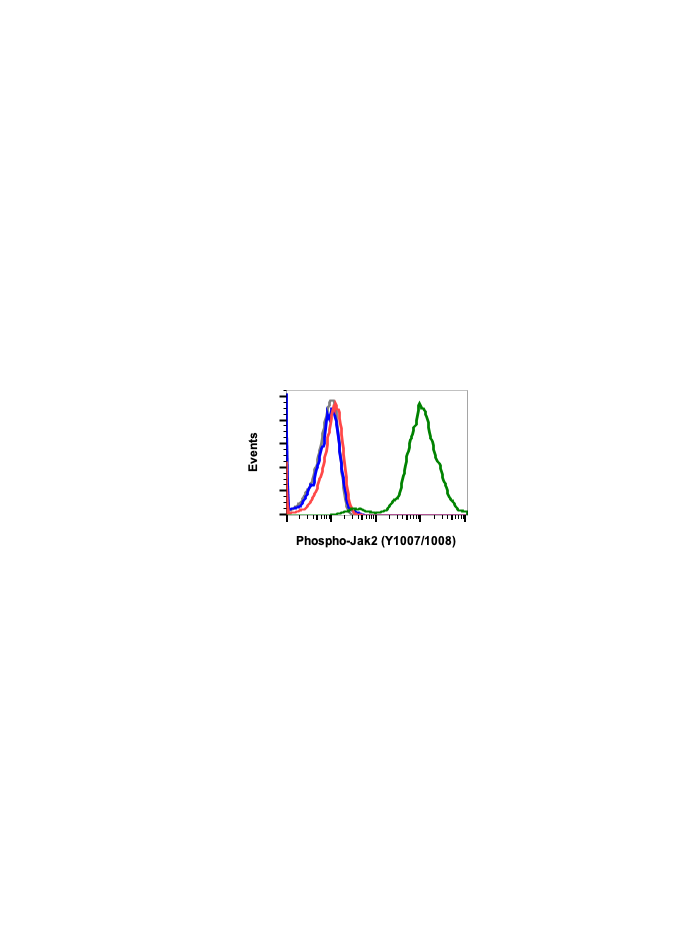Phospho-Jak2 (Tyr1007/1008) (PB6) rabbit mAb
Janus kinases (JAKs) are known as non-receptor protein tyrosine kinases. They serve as the catalytic signaling components for a wide range of cytokine receptors, including the receptors for prolactin, interferons, interleukins 3,5 and 6, granulocyte-macrophage colony-stimulating factor (GM-CSF), erythropoietin, thrombopoietin (TPO), leptin, and growth hormone (1). JAKs comprise four intercellular proteins: JAK1-3 and TYK2 (tyrosine kinase-2). They are constitutively associated with the proximal intracellular membrane region of cytokine receptors. In general, binding of cytokines to the extracellular region of their cognate receptors induces conformational changes leading to phosphorylation of JAKs through reciprocal interaction of two juxtapositional JAKs. Hence, JAK activation requires two JAK isoforms either as homodimers or heterodimers to auto-phosphorylate. Consequently, several different combinations of JAKs are associated with different cytokine receptors to recruit and phosphorylate other signaling molecules including members of STAT family (STAT1, STAT2, STAT3, STAT4, STAT5 or STAT6) of DNA binding proteins (2). Specific cytokine receptors belonging to a subclass that includes erythropoietin receptor (EpoR) and growth hormone receptor (GHR) are homodimeric and bind JAK2 exclusively. Once activated, JAKs phosphorylate specific tyrosine residues on the cytokine receptors and subsequently on signal transducer and activator of transcription (STAT) proteins (3), which are recruited to the phosphorylated receptors through their SH2 (Src-homology 2) domains. STATs are transcription factor and after phosphorylation, they translocate to the nucleus to initiate specific transcriptional programs. JAK–STAT signaling pathways are critical for organismal development and homeostasis, particularly in immunity (3).
| Applications | Flow Cytometry |
|---|---|
| Clone | Jak2Y10071008-PB6 |
| Format | Unconjugated |
| Validated Reactivity | Human |
| Cross Reactivity | Predicted to work with mouse, rat and other homologues. |
| Detection | Anti-Rabbit IgG |
| Clonality | Monoclonal |
| Immunogen | A synthetic phospho-peptide corresponding to residues surrounding Tyr1007/Tyr1008 of human phospho Jak2 |
| Formulation | 1X PBS, 0.02% NaN3, 50% Glycerol, 0.1% BSA |
| Isotype | Rabbit IgGk |
| Preparation | Protein A+G |
| Recommended Usage | 1µg/mL – 0.001µg/mL. It is recommended that the reagent be titrated for optimal performance for each application. See product image legends for additional information. |
| Storage | -20ºC |
| Pseudonyms | Tyrosine-protein kinase JAK2, Janus kinase 2, JAK-2 |
| Uniprot ID | O60674 |
| References | 1. O’Shea JJ., et al., 2013 N Engl J Med, 368:161-70. 2. Levy DE., Darnell JE, 2002 Nat Rev mol Cell Biol, 3:651-62. 3. Alonzi T., et al., 2001 Mol cell. Biol., 21:1621-32. |

